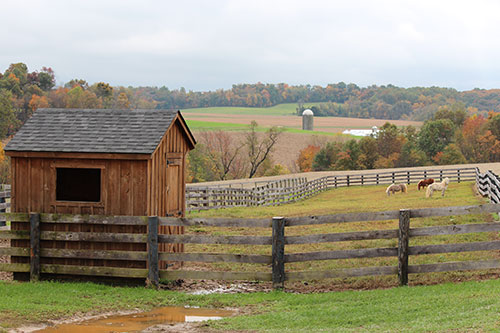Case Study — Preserved Farms in West Fallowfield Township

Location
West Fallowfield Township
Total Township Acreage
11,672 acres
Preserved Farm Acreage
4,019 acres preserved through Chester County's Agricultural Preservation Program
Introduction
Since colonial times, Chester County has had a strong farming identity, and today agriculture remains one of Chester County's leading industries. This is due to the long growing season combined with consistent rainfall, amazing swathes of prime agricultural soils, and being close to Mid-Atlantic markets. Recognizing the importance of this industry and that the land is usually the farmer’s primary asset, County officials in the 1990’s began the farmland preservation program. This program offered the farmer a way to preserve the farm by selling the development rights. At the end of 2017, there were 38,463 acres, or roughly 8 percent of the county's 485,600 acres, of permanently preserved farms, protected forever through the County's Agricultural Preservation Program. This number is even higher when you add the farm acres preserved by the county’s numerous dedicated non-profit land preservation organizations.
An excellent example of how farmland preservation insures the economic viability of farming is found in West Fallowfield Township.
Economic Impact
West Fallowfield Township is located on the western edge of Chester County, bordering Lancaster County. Agricultural activities dominate land use in the Township — the Township's roots lie in agriculture, and today over 71 percent of the Township land remains in agricultural use. To date, over 4,000 acres (34 percent of the Township and 50 percent of its agricultural lands) are preserved farmland. The farms are predominantly in dairy or in a 3-crop rotation (wheat, soybean, corn). There are also some beef cattle, equestrian, and vegetable/cash crops raised.
"Agriculture in West Fallowfield Township is a quiet engine driving the Township's economy"
— John Goodall, Brandywine Conservancy
The economic benefits of the preserved farms are realized in a variety of ways. The direct value of the economic activity, or output, of the preserved farms totals $14.7 million per year. But the supporting facilities such as grain storage facilities, The Oxford Produce Auction, Mid Atlantic Tractor, and other supporting agri-businesses amount to another $6.7 million per year—a total economic output of $21.4 million annually.
This agricultural economy on just 4,019 acres also provides 110 local jobs, with $3.9 million in annual earnings.
Having multiple farmers in proximity participating in land preservation creates market stability. Farmers rarely only farm their own land. Knowing that they can depend on long-term leases on adjoining preserved lands means that they can do long-term business planning that integrates leased lands. Knowing the ground will stay in agriculture also means that the children can look to the farm and think of farming as their future because they know it will be there. By removing the development rights, value is also lowered. This creates a lower bottom line necessary to buy into farming, making transition farming more accessible to next generation farmers. It also reaffirms a rural way of life, and in some ways, society’s investment encourages the next generation to continue in farming. Incidental data shows that preserved land rarely becomes available for sale in West Fallowfield and when it does, it sells faster than in areas that do not have the critical mass necessary to guarantee the supporting infrastructure.
The West Fallowfield Farmland Preservation case study is a classic example of a private industry-government partnership created to insure the economic viability of a critical local commercial resource.


